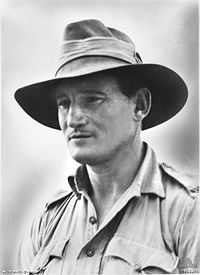Jim Gordon (VC)
| James Gordon | |
|---|---|
 | |
| Born |
7 March 1909 Rockingham, Western Australia |
| Died |
24 July 1986 (aged 77) Repatriation General Hospital, Hollywood |
| Allegiance |
|
| Service/branch | Australian Army |
| Years of service |
|
| Rank | Warrant Officer II[1] |
| Unit | 2/31st Battalion |
| Battles/wars |
|
| Awards | Victoria Cross |
James Hannah (Heather) "Jim" Gordon VC (7 March 1909–24 July 1986) was an Australian recipient of the Victoria Cross, the highest and most prestigious award for gallantry in the face of the enemy that can be awarded to British and Commonwealth forces.
Biography
Gordon was born in Rockingham, Western Australia and grew up in Gingin, Western Australia.
On 26 April 1940 Gordon understated his age and enlisted in the Australian Imperial Force, giving his middle name as Heather.
He married Myrtle Troy at St Edmund’s Church of England, Wembley Park, Perth, on 14 June 1940.
Gordon embarked for the Middle East in September and joined the 2/31st Battalion (a unit formed in Queensland and Victoria), part of the 7th Australian Division, in February 1941.
In June–July 1941, the unit was engaged in the Syria-Lebanon campaign against the Vichy French. It was during the Battle of Jezzine that the following deed took place for which Gordon was awarded the VC:
- On 10 July 1941 at Jezzine, Syria, Private Gordon's company was held up by intense machine-gun and grenade fire from Vichy French forces, but on his own initiative, he crept forward alone and succeeded in getting close to the machine-gun post. He then charged it and killed the four machine-gunners with his bayonet. His action demoralized the enemy in this sector and the company advanced and took the position.
On 12 July 1942, a plaque in his honour was unveiled in front of the Gingin post office. Later that year a portrait of Jim Gordon painted in 1941 by artist William Dargie won the 1942 Archibald Prize, Australia's most famous portrait prize.
Corporal Gordon returned to Australia in March 1942, and after recovering from a bout of malaria, reached Papua in November 1942. In July 1943 he was promoted to sergeant. After seeing further action in New Guinea, he returned to Australia in January 1944. He spent more time in hospital with malaria and performed administrative duties before being discharged on 17 February 1947.
Finding civilian life did not suit him, Gordon joined the Australian Regular Army on 2 December 1947, achieving the rank of Warrant Officer II in 1950. He retired from the army on 1 August 1968, then worked as a groundsman at Campbell Barracks, Swanbourne, until 1975.
Survived by his wife and their son, he died on 19 July 1986 at the Repatriation General Hospital, Hollywood, and was cremated with full military honours. The Jim Gordon ward at the former Repatriation General Hospital has been named in his honour.
See also
Notes
- ↑ Rank shown is the highest rank achieved. Gordon was, however, a private at the time of the deeds that earned him the Victoria Cross.
References
- Udell, Hazel (1980). A History of Gingin: 1830 to 1960. Gingin, Western Australia. ISBN 0-9596765-1-1.
- Jolyon Horner, 'Gordon, James Hannah (Jim) (1907 - 1986)', Australian Dictionary of Biography, Volume 17, Melbourne University Press, pp 448–449.
- Transcript of recommendation for VC
- Laffin, John (2002) [1994]. Forever Forward: The History of the 2/31st Australian Infantry Battalion, 2nd AIF 1940–45. Loftus, Australia: Australian Military History Publications. ISBN 1-876439-33-5.
External links
- Private J.H. Gordon in The Art of War exhibition at the UK National Archives
- 1942 Archibald Prize winner, William Dargie's 1941 portrait of Jim Gordon.
- James Heather Gordon, Who's Who in Australia, p 356, 1980 Edition, Compiled and Edited by W.J. Draper, Melbourne, Australia
-

Dargie painting Gordon's portrait
-

Gordon and the completed picture
-

Right: Sgt Jim Gordon, VC of Gin Gin, WA. 1943-10-01. New Guinea. Lae